St. Martin to Martinique, French Caribbean
Bonjour! If you are longing for the French Riviera, with long afternoons spent lingering over a glass of wine and crusty baguettes or simply for the sound of French, spoken in all of its rustling, sighing glory, but cringe at the thought of long plane trips, no dock space available for the yacht and cold cobalt blue waters, maybe you should consider the alternative. The French Caribbean.
Mais oui, mes amis!
Like other Caribbean islands with a European past, the French Four: St. Martin, St. Barth’s, Guadeloupe and Martinique, are the legacy of the 18th and 19th Century colonial days. Though the mother country no longer pulls all of the strings, the languages and customs of France have remained, now blending with those of the Caribbean to produce a French people with a Caribbean lilt! The French Caribbean has plenty to brag about: perfect weather year-round (yes, the summers here are heavenly, with very few tourists and it is never too warm thanks to the ocean breezes) plenty of golden sand beaches, fabulous French food but with an island twist and warm azure seas. An assortment of fine French wine is readily available, but with the warmth, one does not want to keep it stored for very long, therefore one must be diligent about drinking the wine before it turns. On the other hand, that is one of the most delightful jobs one could ever hope to undertake. “Sorry, can’t go out on the jet ski today we are trying to finish up some of the wine.” Tough job but someone has to do it!
St. Martin
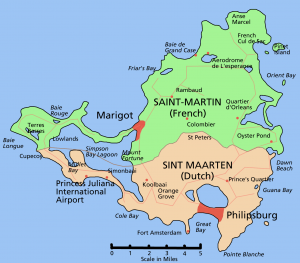
St. Martin is definitely an island with a split personality, actually multiple personalities if you count the overlying Caribbean influence! Only seven miles long, it is politically split, with the northern part being French (Saint Martin) and the southern part being Dutch (Saint Marten), the island is generally referred to as simply “St. Martin”. The story is (totally unsupported by historical fact, it might be added) that while both countries claimed the island for their own, they were both too civilized to fight over it. So one day a Frenchman armed with a bottle of wine walked from one end of the island and a Dutchman armed with a flask of gin proceeded from the other end. Where they met became the boundary. The French ended up with a little bit more because the gin was stronger than the wine! Believe what you will, the story makes about as much sense as anything and it is a lot more fun to boot!
Marigot is the capital of French St. Martin. As picturesque and fashionable as any Riviera seaport, there is an attractive waterfront market and the streets are bursting at the seams with boutiques and restaurants. The market place is always active, but particularly so on Wednesdays and Saturdays when the fruit and fish sellers arrive from Anguilla and Dominica.
If shopping and crowds aren’t your idea of a fun time, try walking up to the old fort. Called Fort St. Louis or Fort Marigot (depending on who you ask) it is a pleasant stroll from Marigot. Not a huge fort, but it is rather an attractive old ruin with a few cannons and a magnificent view across the bay and over Simpson Bay Lagoon as well. Ambling back to Marigot, there are a couple of “must do” things…first is to stop by La Cave de Marigot on Rue Kennedy. The owners are Magali and Benjamin Laurent and not only stock truly fine wines (and lots of them) but live and breathe wines…interesting and knowledgeable, they obviously love what they do. Leaving this wonderful shop behind, head for La Boulangerie Parisienne located near the post office. A fine boulangerie/patisserie, it has a wonderful seating area that is extremely conducive to whiling away hours as you watch the people go by.
If you can finally pull yourself away and have saved some room for dinner set your sights on Grand Case, a small village further on up the coast. Grand Case is a one-street town that is home to 20 (or more!) of the island’s best French restaurants, all offering fabulously elegant repasts such as fig-marbled pate, apricot pie with almond sauce or foie gras with cranberry. With the wonderful wines and incredible food that you will find on St. Martin, it might be hard to pull yourself away to move on to the next island, but there are more delights ahead!
St. Barts
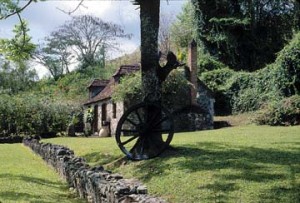
Everyone calls it St. Barts, no one refers to this tiny, eight square mile island as St. Barthelemy. Small, dry and very mountainous an agricultural industry, particularly sugar cane, has always been out of the question. Without sugar cane there were no great plantations and no need to import slaves from Africa. As a result, most of the early residents were fishermen from Normandy and Brittany. Because of this double phenomenon St. Barts always feels more Mediterranean than Caribbean. There are few natives of West Indian descent and the majority of the workers, from chefs to shop girls are French imports.
St. Barts has had two periods in the past where it prospered greatly. In the 1600’s pirates used it as a base. The most famous pirate was Captain Montbars, who was so horrified by what the Spanish had done to the native populations that he decided to avenge them single handedly. He spread so much terror he became know as “Montbars the Exterminator.” He eventually disappeared during a hurricane, though it is rumored his treasure is still buried on the island.
The second period of great prosperity was during the American war of independence, when the American rebels came to St. Barts for supplies. In 1784 the French gave the island to the Swedes in exchange for free port rights in Gothenburg. The Swedes made the island a free port, which it remains today. The Swedes then sold the island back to France in 1878 and it remains French yet today.
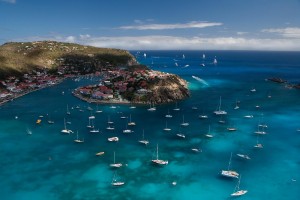
A true gem of the Caribbean, St. Barts sparkles whether you arrive by yacht or by plane. In fact, arriving by plane is a truly exciting way to get to the island, especially if you know that you have a very comfortable charter yacht waiting for you. It’s not the flying, it’s the landing that will have your heart pounding…the plane approaches the miniscule strip by dropping down off the back side of a steep hill, screeching to a halt only yards away from the clear blue waters of the ocean! Great fun and a good way to start your holiday on board! Gustavia is St. Barts’ main town with all of the inherent charm of a small port. Red-roofed buildings abound around the protected harbor. There are about a dozen smaller villages and 20 beaches around the island. The terrain is steep and rugged, perfect for a cruise in a rented moke or Jeep if you’re the adventurous type. One of the best beaches is in walking distance from Gustavia, Anse du Grand Galet, also know as “Shell Beach” which is literally covered with shells.
The restaurants are, of course, spectacular! The hardest part will be choosing which one you want to enjoy. Le Select is a popular informal bar and a very fashionable place to gather for the evening…and has been for years and years. Whether it is feasting in a stylish restaurant, collecting seashells, or sipping a glass of champagne while you “people watch” St. Barts will give you the odd sensation of vacationing in a resort whose boundaries encompass the entire island. No ghettos, litter, crime or violence. And no cruise ships are in sight on this Martinique yacht charter! So wonderful you just might not want to leave, but we still have two more islands of the French Caribbean to explore, so off we go!
Guadeloupe
Like many of the islands in the region the first inhabitants of Karukera (Island of Pretty Waters) were the Arawaks, with evidence of their civilization dating back to several hundred years before Christ. They became extinct around the 9th Century as they fell prey to the fierce Caribs who still inhabited the island when Christopher Columbus landed on November 3, 1493. He promptly named the island Guadeloupe. Guadaloupe is actually two islands, Basse Terre (low land) and Grande Terre (large land). The two islands together form what vaguely resembles a lopsided butterfly. Just to show that someone had a wicked sense of humor at one time, Basse Terre is actually the larger of the two islands and is quite mountainous. Grand Terre is smaller and the hills are much lower. Surrounding Guadaloupe are the outer islands of Marie-Galanet, Les Saintes and La Desirade, slower paced, much less touristy and each with their own special charms.
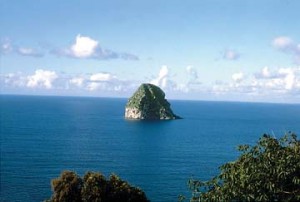
Yes, there are wonderful French restaurants and marketplaces to explore in the luxury resorts lining the white sandy beaches of Gosier and St. Anne. However, possibly the best reason to visit Guadeloupe and its outlying islands is for the natural beauty. The National Park of Guadeloupe has been highly efficient in protecting the lush magnificence and making it accessible for all to enjoy. The Park Service has marked over 300 km of trails, locally called “traces” in the mountains of Basse Terre. There is also the Cousteau Underwater Park, which includes Pigeon Island and northwards up the coast of Guadeloupe for about a mile. It should be noted that the Cousteau Underwater Park is better for scuba enthusiasts than snorkelers, as the waters are quite deep.
There are three excursions not to be missed when visiting Guadeloupe: La Cascade aux Ecrevisses, La Maison de la Foret and Carbet Waterfalls. The first and easiest is La Cascade aux Ecrevisses (waterfall of the crayfish) is a short, flat trail from the route de la Traversee to a lovely waterfall, which falls into a round basin, where once you could find crayfish. The water then runs down into the Corossol River, which is nice for a swim and a picnic! There are actually three easy trails to choose from at La Maison de la Foret (House of the Forest) ranging from 20 minutes to 1 hour to complete. Located again along the Route de la Traversee, they all run around the House of the Forest, and it is possible to explore the rain forest with all of its giant trees, roots and hanging vines. The most spectacular is the 350? Carabet Waterfalls, located in the south of Grande Terre, near the village of Saint-Sauveur.
You might notice the lack of animal life on Guadeloupe as you explore. The greater variety that inhabited the island formerly fell victim first to the arrows of the Indians, then the guns of the colonists, and last but not least, to good intentions. The mongoose was imported to kill the snakes. Remarkably efficient at that, they also succeeded in killing off several other species, including the parrots. So much for good intentions!
Martinique
The southernmost island of the French Caribbean, Martinique is the largest of the Windward islands and apart from a few short spells under British rule, has been French since it was colonized. Not as trendy as St. Barts, slower paced than frantic St. Martin, as lush as Guadeloupe, Martinique might just be the perfect French island get-away! The capital, Fort de France, has heavy car traffic and is generally crowded, but the smaller towns are quieter and are so clean that they look like they have just been scrubbed. The beaches to the south are white and sandy, but the northern beaches are gray volcanic sands.
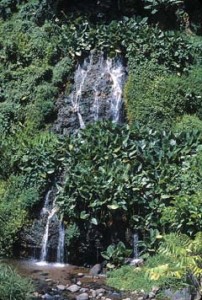 The Empress Josephine grew up in Martinique on a 200 acre, 150-slave estate near Trois Illets. Probably one of the strangest battles in naval history took place near Martinique and as a result it was linked to the Battle of Trafalgar. It happened like this: in 1804 Napoleon was master of Europe but the British still ruled the seas and largely controlled the waters of the Caribbean. Ships being scarce, someone noticed that Diamond Rock on the south coast of Martinique was just about where the British would station a vessel if they had one…so they commissioned the rock as a ship! The steep pinnacle was then equipped with cannons and enough supplies and water for a full crew of men. They held the rock and gave a large surprise to many unsuspecting ships sailing into Martinique. Eventually Admiral Villeneuve was ordered by Napoleon to capture the H.M.S. Diamond Rock. Even though he succeeded, Napoleon was still not real pleased with him, so he was ordered to report in disgrace. Villeneuve preferred death to dishonor, so he put his ill-prepared fleet to sea to fight Nelson at the Battle of Trafalgar. Ironically, Villeneuve who wished to die, survived the battle while Nelson was killed.
The Empress Josephine grew up in Martinique on a 200 acre, 150-slave estate near Trois Illets. Probably one of the strangest battles in naval history took place near Martinique and as a result it was linked to the Battle of Trafalgar. It happened like this: in 1804 Napoleon was master of Europe but the British still ruled the seas and largely controlled the waters of the Caribbean. Ships being scarce, someone noticed that Diamond Rock on the south coast of Martinique was just about where the British would station a vessel if they had one…so they commissioned the rock as a ship! The steep pinnacle was then equipped with cannons and enough supplies and water for a full crew of men. They held the rock and gave a large surprise to many unsuspecting ships sailing into Martinique. Eventually Admiral Villeneuve was ordered by Napoleon to capture the H.M.S. Diamond Rock. Even though he succeeded, Napoleon was still not real pleased with him, so he was ordered to report in disgrace. Villeneuve preferred death to dishonor, so he put his ill-prepared fleet to sea to fight Nelson at the Battle of Trafalgar. Ironically, Villeneuve who wished to die, survived the battle while Nelson was killed.
History also takes an ironic twist in Martinique’s story with the eruption of Mount Pelee. At the time of the eruption, St. Pierre with a population of 30,000 was the capital of Martinique and known as the Paris of the Caribbean. May 8, 1902 was Ascension Day in St. Pierre. Mount Pelee had been rumbling for several days prior. As early as May 2 there had been a minor eruption that covered the city with enough ash to kill some birds and animals. Later that day a local planter had gone to inspect his crops with a party of workers and all were swept away by a vast avalanche of boiling volcanic mud. When the end came there were plenty of witnesses, as people were approaching from Fort de France for the Ascension Day church service. They saw heavy red smoke from the volcano descend on St. Pierre. At two minutes past eight in the morning, the side of the volcano facing St. Pierre glowed red and finally burst, releasing a torrent of volcanic effluent. Mud, lava, boiling gases and rocks poured down on St. Pierre. All that remained were smoking ruins. Twelve ships in the bay were destroyed at anchor. An estimated 29,933 people burned to death. The only two survivors were Leon Leandre, a cobbler who was in his cellar and Cyparis, imprisoned for murder in a stone cell. This might be the only time where one could imagine that crime did pay, at least for Cyparis!
Martinique simply has too much to do to try and only spend a few days there. The bustling marketplaces in Fort de France, the chic boutiques that line the narrow streets, the many museums (including one honoring Gauguin, located in Carbet) the greenery of La Savane Park, rather like a Bois de Bologne of Fort de France, the lush rain forest…hike it, drive it, but take the time to experience it! Martinique? C’est Magnifique! The French Caribbean has all the wonderful foods, fine wines and sounds of the French language that make you wish you were in the French Riviera, only less expensive, less crowded and with more sunshine all year round…not to mention there are miles and miles of white sandy beaches in the French Caribbean than in all of the French Riviera.
What are you waiting for? The champagne is already chilled!
ITINERARY
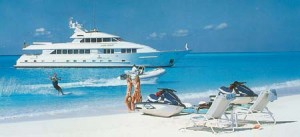 Day 1: Arrive in St Maarten, an island of gently rolling hills rimmed with flawless beaches interrupted only by coves and bays cut into the coastline. After being met by the crew at The Princess Juliana Airport, you can enjoy a relaxing afternoon dockside as you join the yacht at The Princess Yacht Club or Isle del Sol Marina. Spend the afternoon amid the paparazzi on Orient Beach, or take the five minute boat ride to nearby Marigot to do some world class shopping. Once back at the yacht, allow your crew to arrange for a spa treatment at the resort or lounge around as the chef prepares dinner for you and your guests.
Day 1: Arrive in St Maarten, an island of gently rolling hills rimmed with flawless beaches interrupted only by coves and bays cut into the coastline. After being met by the crew at The Princess Juliana Airport, you can enjoy a relaxing afternoon dockside as you join the yacht at The Princess Yacht Club or Isle del Sol Marina. Spend the afternoon amid the paparazzi on Orient Beach, or take the five minute boat ride to nearby Marigot to do some world class shopping. Once back at the yacht, allow your crew to arrange for a spa treatment at the resort or lounge around as the chef prepares dinner for you and your guests.
Day 2: After breakfast, relax on the boat deck as the yacht departs St Marten’s Simpson Bay. A short two hour cruise brings you to the wonderful Island of St Barths. Once the yacht is anchored in Gustavia Harbor take a ride in the tender or head to town. Gustavia offers visitors a wealth of boutiques, duty free shops, some good restaurants, and a colorful open-air market. Among the island’s natural riches is a small tree called the Gaiac, which comes from native Carib’s word for “Tree of Life”. It blooms a striking deep blue and can be seen all over the island. After a five star dinner prepared by the chef travel by limo to the ritzy center of St Barths to take in its nightlife.
Day 3: Join your guests on the aft deck for breakfast as the crew prepares for the yacht’s departure. Relax in the sun on the upper deck as you set course for the island of Antigua, only 6 hours way. Once tied up at Falmouth Harbors Yacht Club venture ashore or take a cruise around the harbor in the launch. Take a horseback ride on a nearby beach or allow the crew to arrange for a helicopter ride to see an active volcano on the nearby island of Montserrat. If physical fitness is your forte, work out on the upper deck, or take the scenic hike up to Shirley Heights for a breathtaking view of the Harbor and the rest of the island.
Day 4: Wake to the smell of fresh baked muffins as the chef prepares breakfast to be served in the open air on the aft deck. Today’s destination is Harmony Hall located in Antigua’s Nonsuch Bay. This is a wonderful area where only a reef lies between the yacht and the Atlantic Ocean, rolling in unbroken from Africa. Run around on the wave runners, or join the crew for a snorkeling adventure on the inside reef just off of Green Island. Once back on the yacht enjoy a Goombay Smash on the boat deck. This island drink made famous in Harbor Island near Eleuthera, is a favorite in the Caribbean. As your chef prepares a “Lobster Feast”, kick back, relax, and take in the sunset bringing with it the end of another wonderful day.
Day 5: Take in a final view of Antigua as you depart Nonsuch Bay for the six hour cruise across the Guadeloupe Passage to the French island of Guadeloupe. This island, once known by the Caribs as, Karukera, which means “Island of Beautiful Waters,” is the largest in the Leeward chain. Guadeloupe is a water sports enthusiasts’ paradise. In fact, it is on Jacques Cousteau’s top ten list for best places to dive worldwide. Once docked at The Marina Bas Du Fort in Pointe-a Pitre venture ashore to see a bustling waterfront with brightly colored umbrellas and gaily dressed market women surrounded by heaps of fruits and vegetables.
Take in the Creole atmosphere as you walk along the streets lined with fascinating gingerbread style buildings. The thirty minute walk through a rain forest to the 350 foot Carbet Waterfalls is another experience not to be missed. After a long day of activities join the crowd back on the yacht for an island style barbeque on the boat deck complete with reggae theme and dress.
Day 6: Today’s journey brings you to the island of Dominica. The island originally called, Wai’tukubli, which means ” Tall is her body,” is an apt term for an island whose 5,000 foot peak often has its head in the clouds. Exceptional dive sites are found on the north and its northeast coast. Reefs teem with colorful sponges and glowing crinoids, forming a home for rays, batfish, squid, and seahorses. Dive the drop-off known as “The Wall”, an underwater volcano, which offers caverns filled with sea life, and crusty corals including a rare black coral. Take the 20 minute hike up to Trafalgar Falls on the west side of Morne Microtin. Watch high above as the crystal clear water comes crashing down making a spectacular scene in the pool below. Once back on board, relax as the yacht rides easy at anchor in the surrounding turquoise water.
Day 7: Wake to the sound of the yacht in motion as you depart Guadeloupe for Martinique. The island known as the Paris of the Antilles, has one of the highest standards of living in the Caribbean. Its fine French restaurants, and shops along with an International Airport, make Martinique a popular destination for visitors. After a walk around the island’s capital, Fort de France, join the crew back on the yacht for a sport fishing excursion in the tender. Fish the islands outer reef for Tuna, Barracuda, Kingfish, and Bonito. With a fresh catch in hand relax onboard as the chef prepares dinner for you and your guests.
(Thanks to International Yacht Collection for the above itinerary):
Contact Us Today
Call or text now: +1 954-632-3555
Email: info@allyachtsworldwide.com
